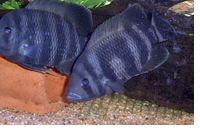Tilapiines
The Tilapiines Species
 Malawi cichlids are separated into two main groups, Haplochromines and Tilapiines. Haplochromines are then divided into two sub groups or genus, Haplochromis and Mbuna. These two genus are then separated into species. The Tilapiines is a tribe within the family cichlidae commonly known as Tilapiine cichlids. Most of the taxa herein are called "tilapias", a diverse and economically important group containing the genera Oreochromis, Sarotherodon and Tilapia. A number of smaller genera, such as Alcolapia, Danakilia, Iranocichla and Steatocranus are also placed herein. They are nowadays placed in the subfamily pseudocrenilabrinae of African cichlids; formerly these were often regarded as a distinct subfamily Tilapiinae. Like other cichlids, Tilapiines exhibit complex reproductive behaviours and guard their eggs and fry.
Malawi cichlids are separated into two main groups, Haplochromines and Tilapiines. Haplochromines are then divided into two sub groups or genus, Haplochromis and Mbuna. These two genus are then separated into species. The Tilapiines is a tribe within the family cichlidae commonly known as Tilapiine cichlids. Most of the taxa herein are called "tilapias", a diverse and economically important group containing the genera Oreochromis, Sarotherodon and Tilapia. A number of smaller genera, such as Alcolapia, Danakilia, Iranocichla and Steatocranus are also placed herein. They are nowadays placed in the subfamily pseudocrenilabrinae of African cichlids; formerly these were often regarded as a distinct subfamily Tilapiinae. Like other cichlids, Tilapiines exhibit complex reproductive behaviours and guard their eggs and fry.
Broadly speaking, the plesiomorphic trait is substratum-spawning behavior, meaning that the fish form pairs, lay the eggs on a rock or into a depression made in the substrate, and then both parents guard the eggs and fry. Oreochromis and Sarotherodon are mouthbrooders, carrying the eggs and fry in their mouths instead of placing them in a nest. The numerous Oreochromis species are maternal mouthbrooders, meaning that only the female looks after the eggs and fry, with the male offering no protection or help at all. Instead, they form leks where they compete with one another for further opportunities to mate with females.
By contrast, most of the far fewer Sarotherodon species are biparental mouthbrooders, with both parents protecting the eggs and fry. A few, such as Sarotherodon Melanotheron, are paternal mouthbrooders, with only the male caring for the eggs and fry. In addition, some species usually placed in Oreochromis might belong into Sarotherodon. Either this is incorrect due to hybridization effects, or they are not maternal mouthbrooders, or the diversity of brood care is even higher among the smallest group of tilapias than it was hitherto believed. For more information about Tilapiines visit Wikipedia Tilapiines
Page last updated on

 Tilapiines
Tilapiines